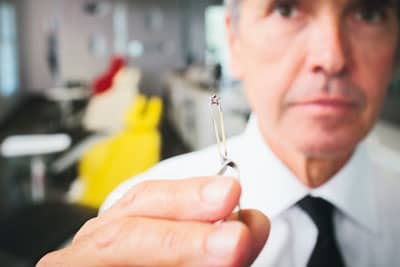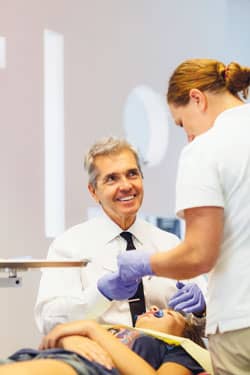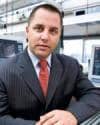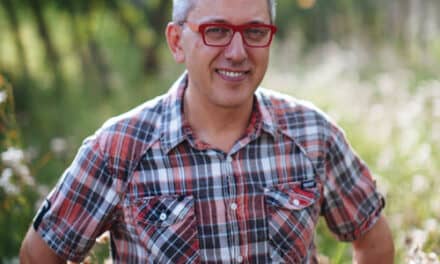By Lori Sichtermann | Photography by Colin Conces
In many ways, all orthodontists are artists. They see with their mind’s eye, they work delicately with their hands, and they take pride in the beauty of the finished product. In the case of Clarke Stevens, DDS, MS, his experiences working in the realm of sculpture led him to the profession.
When Stevens was young, he dreamed of being an architect. Having abundant creativity and a critical mind for mechanics, at the age of 13, he convinced his mom to purchase a copper fountain building kit. He applied precision, patience, artistic ability, and an acute technical understanding. The result: museum showings of his fountains and subsequent sales to private collectors.
“I’ve always enjoyed design, and I liked the complexity of working with the wire and creating something beautiful,” Stevens notes. “I had braces at the time, and working with the wire and the tools really got me thinking about becoming an orthodontist.”
| Practice Profile: Orthodontic Associates |
|
Office square footage: 2,400 Years in practice: 32 Education: DDS from the University of Nebraska Dental College; Masters in orthodontics from the University of North Carolina, Chapel Hill Average patients per day: 45 Days worked per month: 11 Top products used: 018 Twin Brackets (Roth RX) are Stevens’ brackets of choice, and he purchases everything as a manufacturer because of WildSmiles. Website: bracesomaha.com |
Encouraged by artistic success in his native Omaha, Neb, Stevens continued to build fountains. “Some were displayed in museums, others were sold,” he recalls. “I was fortunate enough to sell my pieces throughout my school years, which helped a lot.”
Schooling for Stevens meant 2 years of undergraduate work before earning a bachelor’s degree from the University of Nebraska Dental College and a master’s in orthodontics from the University of North Carolina, Chapel Hill. In 1980, Stevens returned to Omaha and opened his current practice, Orthodontic Associates.
While he may have traded his art studio for a dental practice, Stevens still attends to his work with a strong sense of creativity, dedication, and pride. “I’m often asked why I didn’t go into art as a profession, and my answer is always the same: It’s too lonely,” Steven says. “I really enjoy interacting with people and helping them. Orthodontics is the perfect fit for me because I can be social, creative, and I have the opportunity to really help someone.”
Taking Care
It goes without saying that every orthodontic practice is unique in its own way. Some are high-tech, high-volume offices buzzing with gadgets and staff, while others are low-key, laid-back environments that offer patients the ability to slow down, relax, and be at peace. In every instance, the tone and pace of the practice is a direct result of the orthodontist and his or her staff. At Orthodontic Associates, with Stevens at the helm, Omaha-area residents are privy to quite a unique orthodontic experience.
“We care for people like we want to be cared for,” Stevens explains. “I try to extol my two practice principles when it comes to patient care and customer service. First, the golden rule: Do unto others as you would have them do unto you. Second, do it with a smile.”
With a team of five, Stevens runs his practice and his business on a handful of solid maxims. The proverbial golden rule is always a great place to start, but Stevens also draws inspiration and business lessons from other, nondental sources. One of which is Herbert Marcus, co-founder of the Dallas-based retailer Neiman Marcus.
“He believed in what he called ‘equity’—that everyone should be treated equally and with respect,” Stevens notes. “Marshall Field said, ‘Give the lady what she wants.’ I say, ‘Never underestimate the [influence] of critical judgment or the power of a discriminating consumer.’ “
In the more than 3 decades since Stevens opened his practice, he has found success by adhering to these principles of business. And, as he explains, he’s privileged with a staff of talented and caring individuals who share in his quest for quality care and services.
“It boils down to this: Discriminating people never settle for less than the best, and neither do [we],” Steven adds. “They can make or break a practice, and I’m always thankful for my staff’s understanding of this fact. Everyone goes out of their way to make sure the patient’s needs are met.”
Although he’s found success as a result of his business principles, Stevens admits to having the accidental “ah-ha” moment that caused him to shift his perception a bit. The result of which has been a different approach to patient care.
“Years ago, I had a young patient’s mom suggest that I had crossed the line by asking her son about his dad—an acquaintance of mine from years ago,” Stevens explains. “The parents were divorced, and I had unknowingly offended the mom by inquiring about her ex-husband. She said it was not my job to ask personal questions. It was my job to straighten her son’s teeth.”
As Stevens explains, the encounter with the patient’s mother made him take a step back and evaluate his interactions with all patients and their families. “The experience was humbling, and it taught me to look at every aspect of my business from the patient’s point of view.”
 Creative Minded
Creative Minded
Once an artist, always an artist—this is certainly the case with regard to Stevens. Throughout the 30 plus years as a practicing orthodontist, he’s continued to apply his strong sense of creativity to his work. And, like most artists, he can’t just “turn it off” when he’s away from patients.
“When I’m out of the office, I’m constantly looking at people with the eye of an orthodontist, as well as an artist,” he notes. “I think to myself, ‘How can I make that man’s jaw look better?’ Or, ‘How could I make that woman’s alignment look better?’ Everyone has a unique occlusion, and orthodontists get to figure out how to correct it.”
Stevens was drawn to orthodontics as a young man because of the creative avenues that the profession promised. However, he also had a desire to help people. And, as his career has proven, it’s this aspect that truly makes him a notable presence in Omaha and the orthodontic community.
“At my practice, my ‘specialty’ is caring for patients,” he notes. “There are personalities attached to the teeth that I see every day. We have to care for the person, too.”
Stevens notes a recent study conducted by the American Academy of Cosmetic Dentistry that states 90% of people perceive a smile as a necessary attribute for personal success. “As orthodontists, we give people a positive benefit for the rest of their lives,” Stevens adds. “It’s a great way to spend your day—changing people’s lives by giving them a wonderful smile.”
With regard to technology—an element of orthodontics that seems to be forever advancing—Stevens is equally grounded in his approach toward this area of the field.
“Technology plays a very large part in our practice. Our office is paperless, which has increased efficiencies in a number of areas, and we have the most advanced systems needed for patient care. Yet, we’re not a tech-centric kind of practice,” he notes. “For my practice, I look at it this way: Just because something is new, doesn’t mean it’s necessary to the way I practice. As a business owner and a professional, I have to be discriminating with what I choose to put into my office.”
In fact, Stevens has a very stylized way of approaching the subject of technology. It’s one that mirrors the mission of specialized care and acute customer service. “I consider my practice to be high-touch and not high-tech,” Stevens adds. “We’re not just focused on technology. We’re focused on the patient and making sure they have a positive experience with us.”
 A Different Class
A Different Class
In addition to running a successful practice, Stevens also is a member of the American Dental Association and the American Association of Orthodontists. His expertise in the area of dentofacial orthopedics has led to numerous invitations to speak to audiences at conferences and meetings across the country and around the globe.
With this specialized knowledge, Stevens helped to develop—and later co-direct—the dentofacial deformity program at the University of Nebraska Medical Center. “When I began my career in Omaha, I realized the med-center didn’t have a program dedicated to issues pertaining to the jaw,” he explains. “Together, with the university’s oral surgery chairman, Dr Leon Davis, and his colleague, Dr Harold Tu, we founded the dentofacial orthopedics program.”
As if developing and co-directing a dentofacial program was not a time-consuming labor of love, Stevens also has taught in a variety of roles within local academia since 1980. Most recently, he served as an assistant professor of orthodontics at the University of Nebraska and held a teaching position at Creighton University School of Dentistry.
Running a successful practice while also teaching the next generation of orthodontists is understandably a significant commitment. But, as Stevens explains, it’s one he’s more than happy to make. “While in orthodontics school, I trained under Dr Bill Proffit at UNC. He’s my mentor, and inspired me to give back to the profession,” Stevens says. “I remember when I first started the program, I’d never been in an environment where the faculty believed in me with such wholeheartedness. I like to pass that same feeling along to the students I teach.”
Stevens has been in the classroom with aspiring orthodontists for more than 15 years. While his focus is primarily orthodontic surgery, he’s also been asked, in recent years, to teach some basic principles of patient care. “My underlining message on this topic is never settle for less than the best,” he notes.
“Regardless of what I’m teaching, I love the interaction with students,” Stevens adds. “I particularly like the moment when you can see that a student ‘gets it.’ “
Teaching at the university level has been incredibly fulfilling for Stevens. He’s had the opportunity to work alongside respected colleagues and gain new insight from each class of students. As satisfying as the experience has been, Stevens is still concerned about the future of the marriage between orthodontics and academia.
“A lot of programs across the country are struggling to find faculty, which I think is incredibly unfortunate,” he explains. “Not too many people have the desire to give back anymore. It’s a shift in thought that is concerning in our industry, and in our culture as a country.”
Anyone who has been to school can name a teacher who left an impact. For Stevens, too few people see the value in teaching and making a difference for students today. “Maybe we’re too busy or the culture might be telling us to seek other things for ourselves. We don’t always realize the real value of life is how we serve or give back to others.”
In many ways, Stevens is a servant to his profession. Throughout his career, he’s contributed countless hours toward ensuring that the future of orthodontics remains strong and vibrant. From teaching, to delivering lectures to developing and directing programs at the university level, Stevens is dedicated to making a difference in orthodontics.
Like any professional, Stevens’ career thus far has been one of learning experiences—taking the good with the bad and learning as much as possible from each. With each step along the way, he often recounts the words of his mentor years ago.
“On our first day of orthodontics school, Dr Proffit told all of us residents, ‘You’re all here because you’re bright. So, I’m not going to worry too much about grades. Instead, I’m going to focus on teaching you how to think.’
“For me, it was a revolutionary statement,” Stevens adds. “That was a concept I had not heard all through my prior education. In orthodontics, learning to think is the beginning of success.” OP
Wild Success |
|
Just over 20 years into his career as an orthodontist and owner of Omaha-based Orthodontic Associates, Stevens was tending to a 9-year-old patient when his artist’s eye and orthodontic intuition aligned. “I noticed the patient was wearing a heart-shaped charm necklace—the charm was about the size of a bracket,” Stevens recalls. “I started to think, and then finally asked if she would want heart-shaped braces. She said, ‘Yes.’ That’s how I began the WildSmiles journey.” Stevens contacted a US manufacturer of brackets and began producing his line of WildSmiles Braces™ in the shape of hearts, as well as stars, flowers, soccer balls, footballs, and diamonds. The brackets are manufactured to exacting standards in a Roth/MBT prescription for the maxillary anterior teeth. And, as Stevens explains, they are suitable, if not perfect, for early or full-phase treatment. “WildSmiles is unique in orthodontics because they allow patients to be their own person and embrace expression,” Stevens notes. “Patients at this age love to make a choice—even if they choose ceramic or plain braces—because it’s their decision. They own it!” While many of the younger set are on board with the concept and design of WildSmiles, Stevens is eager to express his excitement for the brackets to his colleagues. “WildSmiles braces have been meticulously engineered to provide optimum esthetic and functional benefits,” he notes. “They were designed with kids in mind, but they also offer benefits to the orthodontist. These are quality brackets, but with a bit of flair to them.” According to Stevens, the response to WildSmiles from the orthodontic community has been positive. “Understandably, doctors want to confirm these aren’t just a fad or a gimmick. They want to make sure they are quality brackets and that they’ll perform,” he notes. “As orthodontists, we have to constantly evaluate the appliances we use because we’re responsible for the quality of the care we provide. That’s what makes the WildSmiles brackets unique. They’re designed by an orthodontist. I hold them to even higher standards than any other orthodontist because they have my name on them.” For Stevens, the concept behind WildSmiles aligns perfectly with his impulse to help others. Considering the orthodontic process from a young patient’s perspective, he sees that it can be intimidating, if not downright scary. However, as he explains, giving patients the choice of characterization lessens the anxieties that come with sitting in the chair. “It’s great to see that something so small can have such a big impact,” Stevens explains. “Having shaped brackets makes the process of getting braces more fun.” -LS |



 Creative Minded
Creative Minded A Different Class
A Different Class Clarke Stevens DDS, MS, came to the orthodontic profession with the critical eye of an artist. Throughout his schooling, he was able to create, exhibit, and sell copper fountains in his native Omaha and the surrounding areas. It was his sense of creativity and appreciation for technical application that led him to pursue a career in orthodontics.
Clarke Stevens DDS, MS, came to the orthodontic profession with the critical eye of an artist. Throughout his schooling, he was able to create, exhibit, and sell copper fountains in his native Omaha and the surrounding areas. It was his sense of creativity and appreciation for technical application that led him to pursue a career in orthodontics.







